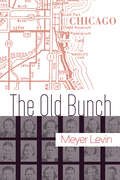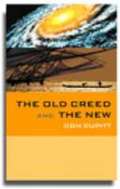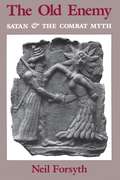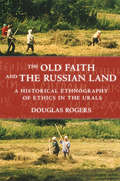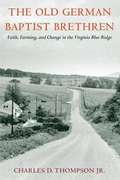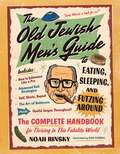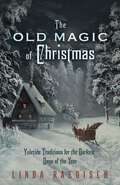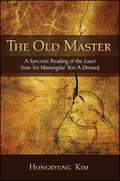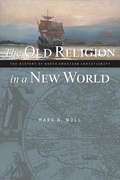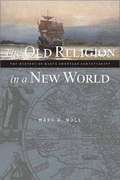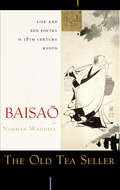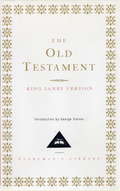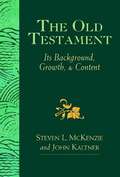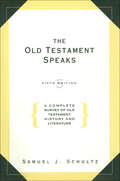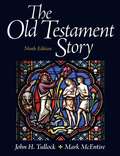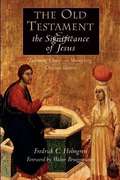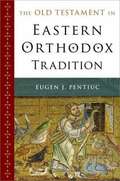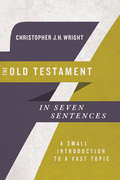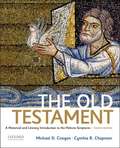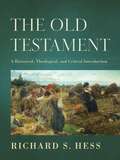- Table View
- List View
The Oil Has Not Run Dry: The Story of My Theological Pathway
by Gregory BaumBorn to a Jewish mother and Protestant father in 1923 Berlin, Gregory Baum has devoted his career to a humanistic approach to Catholicism. In The Oil Has Not Run Dry, Baum shares recollections about his lifelong commitment to theology, his atypical views, and his evolving understanding of the Catholic Church’s message. Baum reflects on his groundbreaking work with the Second Vatican Council (1962-65) and how it helped to open the Church to a new understanding of outsiders - one that advocated cooperation with world religions in support of peace and justice and respected secular philosophies committed to truth and social solidarity. Later embracing Latin American liberation theology, he became a leading thinker of the Catholic Left in Canada, adopting radical positions that initially earned support from Canadian bishops in the 1970s. Diverging from official Catholic doctrines regarding women and sexual ethics, Baum eventually left the priesthood, but continued to teach theology and remained active in the Church. The Oil Has Not Run Dry also discusses the contrast between Catholicism in Quebec and English-speaking North America, and the ways in which Baum sees Quebec’s culture as more marked by social solidarity. This significant difference has inspired his own writings which present the original development of Catholic thought in Quebec to an English-speaking readership.
The Oil Has Not Run Dry: The Story of My Theological Pathway (Footprints Series #23)
by Gregory BaumBorn to a Jewish mother and Protestant father in 1923 Berlin, Gregory Baum devoted his career to a humanistic approach to Catholicism. In The Oil Has Not Run Dry, Baum shares recollections about his lifelong commitment to theology, his atypical views, and his evolving understanding of the Catholic Church’s message. Baum reflects on his groundbreaking work with the Second Vatican Council (1962-65) and how it helped to open the Church to a new understanding of outsiders - one that advocated cooperation with world religions in support of peace and justice and respected secular philosophies committed to truth and social solidarity. Later embracing Latin American liberation theology, he became a leading thinker of the Catholic Left in Canada, adopting radical positions that initially earned support from Canadian bishops in the 1970s. Diverging from official Catholic doctrines regarding women and sexual ethics, Baum eventually left the priesthood, but continued to teach theology and remained active in the Church. The Oil Has Not Run Dry also discusses the contrast between Catholicism in Quebec and English-speaking North America, and the ways in which Baum sees Quebec's culture as more marked by social solidarity. This significant difference has inspired his own writings, which present the original development of Catholic thought in Quebec to an English-speaking readership.
The Old Bunch
by Meyer LevinThe Old Bunch chronicles the lives of nineteen Jewish men and women on Chicago's west, a spawling-yet-intimate portrait of American life during the Great Depression, by an author the LA Times hailed as "the most significant American Jewish writer of his time."Among the various lives depicted so vividly are those of Joe Feeman, a wayward artist who loses the love of his life to a doctor whose future path is as clear as Joe's is uncertain. Sam Eisen appears to be following a stable path into law, but in actuality his contempt for the conformist lifestyles of his friends is second only to the distain he feels for the very life he has chosen. Sol Meisel starts out pursuing his dreams of becoming a professional athlete, before settling down to join his father's business. Interweaving storylines of rebellion and growing up, Levin unsentimentally generates a worldview that is striking in its pre-World War II innocence, while also clearly delineating the old world from the new.The Old Bunch is one of the great novels of and about the interwar period. Both of its time and remarkably fresh, it is an outstanding achievement by a preeminent American writer.Norman Mailer referred to Levin as "one of the best American writers working in the realistic tradition." Ernest Hemingway called his book Citizens "a fine American novel - one of the best I ever read." In 1957, Levin won the Special Edgar Award for his book Compulsion, the renowned account of the Leopold and Loeb murders and the basis for the 20th Century Fox motion picture.This edition has been authorized by the Estate of Meyer Levin.REVIEWS"The Old Bunch is written in good hard-driving colloquial prose, and is full of sharp characterizations... A very fine novel with the speed and lustiness and brawling of the world's fourth largest city." --New Republic"A landmark in the development of the realistic novel... incident by incident it makes vivid and exciting reading... it brilliantly succeeds in taking the reader on a memorable tour of the world in which the "old bunch" lived." --NY Times
The Old Creed and the New
by Don CupittThe Old Creed and the New is Don Cupitts latest writing in his on-going project to modernize religious thought. His previous works have argued that since the Enlightenment almost every new movement in Christianity has been neo-Conservative and authoritarian. Here he looks to the liberal theologians of a hundred years ago who attempted to modernize religion but were often content merely to simplify and liberalize the creed. Todays radical theology, he argues, contrasts by beginning to produce something so different from traditional religion that the public may at first feel baffled by it. Don Cupitt here sharply juxtaposes the traditional Apostles creed of western Christianity and the emergent creed of modern radical theology. Side by side, they look amazingly different, and Cupitt carefully explains what is happening, and why. The main change, he argues, is that the old creed situated the believer within a huge narrative cosmology, the central myth of a great religion-based civilization, whereas the new creed merely defines the bare outlines of a modern spirituality. The new religion emerges as being scarcely creedal at all: it is the practice of solar living. People no longer look up: instead, they are content simply to claim their own lives, to find their own way of living them, and to live life to its fullest. Just ordinary life itself is now the religious object - which shows the post-protestant character of the new outlook. The Old Creed and the New tries to define and situate this new kind of religion, and encourages the reader to think about it both intellectually and spiritually.
The Old Enemy: Satan and the Combat Myth
by Neil ForsythThe description for this book, The Old Enemy: Satan and the Combat Myth, will be forthcoming.
The Old Faith and the Russian Land: A Historical Ethnography of Ethics in the Urals (Culture and Society after Socialism)
by Douglas RogersThe Old Faith and the Russian Land is a historical ethnography that charts the ebbs and flows of ethical practice in a small Russian town over three centuries. The town of Sepych was settled in the late seventeenth century by religious dissenters who fled to the forests of the Urals to escape a world they believed to be in the clutches of the Antichrist. Factions of Old Believers, as these dissenters later came to be known, have maintained a presence in the town ever since. The townspeople of Sepych have also been serfs, free peasants, collective farmers, and, now, shareholders in a post-Soviet cooperative.Douglas Rogers traces connections between the town and some of the major transformations of Russian history, showing how townspeople have responded to a long series of attempts to change them and their communities: tsarist-era efforts to regulate family life and stamp out Old Belief on the Stroganov estates, Soviet collectivization drives and antireligious campaigns, and the marketization, religious revival, and ongoing political transformations of post-Soviet times. Drawing on long-term ethnographic fieldwork and extensive archival and manuscript sources, Rogers argues that religious, political, and economic practice are overlapping arenas in which the people of Sepych have striven to be ethical-in relation to labor and money, food and drink, prayers and rituals, religious books and manuscripts, and the surrounding material landscape.He tracks the ways in which ethical sensibilities-about work and prayer, hierarchy and inequality, gender and generation-have shifted and recombined over time. Rogers concludes that certain expectations about how to be an ethical person have continued to orient townspeople in Sepych over the course of nearly three centuries for specific, identifiable, and often unexpected reasons. Throughout, he demonstrates what a historical and ethnographic study of ethics might look like and uses this approach to ask new questions of Russian, Soviet, and post-Soviet history.
The Old German Baptist Brethren: Faith, Farming, and Change in the Virginia Blue Ridge
by Charles D. Thompson Jr.Since arriving nearly 250 years ago in Franklin County, Virginia, German Baptists have maintained their faith and farms by relying on their tightly knit community for spiritual and economic support. Today, with their land and livelihoods threatened by the encroachment of neighboring communities, the construction of a new highway, and competition from corporate megafarms, the German Baptists find themselves forced to adjust. Charles D. Thompson Jr.'s The Old German Baptist Brethren combines oral history with ethnography and archival research--as well as his own family ties to the Franklin County community--to tell the story of the Brethren's faith on the cusp of impending change. The book traces the transformation of their operations from frontier subsistence farms to cash-based enterprises, connecting this with the wider confluence of agriculture and faith in colonial America. Using extensive interviews, Thompson looks behind the scenes at how individuals interpret their own futures in farming, their hope for their faith, and how the failure of religiously motivated agriculture figures in the larger story of the American farmer.
The Old Jewish Men's Guide to Eating, Sleeping, and Futzing Around
by Noah RinskyFrom the viral social media account @oldjewishmen comes a hilarious and irresistible guide and perfect gift for every OJM and the people who put up with him Here is a humorous, surprisingly stylish, and crotchety celebration of a most fascinating group of fellas: Old Jewish Men. In this essential guide, readers learn how to eat, dress, get around town, and schmooze like a seasoned OJM. Ever wonder why Old Jewish Men eat so much cottage cheese and melon? If Larry David and Bernie Sanders have the same barber? Who is the next great up-and-coming OJM? (NOTE: You don&’t need to be old, Jewish, or a man—it&’s a lifestyle.) Plus, there&’s helpful jargon, detailed deli and coffee shop rundowns, and the ten OJM archetypes, from New York Schlubs to Tough Guys to Grumpy Intellectuals. A perfect gift for any Jewish dad/granddad/uncle/brother or anybody who likes a healthy shmear of classic Jewish humor, the book is full of hilarious full-color illustrations and chapters including: How to Exist in This Fakakta World; The Art of the Schmooze; How to Live Forever; and King of the Temple.
The Old Magic of Christmas: Yuletide Traditions for the Darkest Days of the Year
by Linda Raedisch'Tis the Season for Witches, Elves, and a Legion of GhostsNot so very long ago, Yuletide was as much a chilling season of ghosts and witches as it was a festival of goodwill. In The Old Magic of Christmas, you'll rub elbows with veiled spirits, learn the true perils of elves, and discover a bestiary of enchanted creatures. Rife with the more frightful characters from folklore and the season's most petulant ghosts, this book takes you on a spooky sleigh ride from the silvered firs of a winter forest to the mirrored halls of the Snow Queen. Along the way, you'll discover how to bring the festivities into your home with cookie recipes and craft instructions, as well as tips for delving more deeply into your relationship with the unseen.Praise:"Steeped in history and adorned with a bit of enchantment, The Old Magic of Christmas is the perfect book to read by a winter's fire with a mug of mulled cider in hand."—Deborah Blake, author of The Witch's Broom"...[A] fascinating journey into the stories behind the tinsel and bows."—Doreen Shababy, author of The Wild & Weedy Apothecary"...[A]n intriguing little tome that explores the darker side of the Yuletide holiday."—Ellen Dugan, author of The Enchanted Cat
The Old Master: A Syncretic Reading of the Laozi from the Mawangdui Text A Onward (SUNY series in Chinese Philosophy and Culture)
by Hongkyung KimThis unique, highly contextualized translation of the Laozi is based on the earliest known edition of the work, Text A of the Mawangdui Laozi, written before 202 BCE. No other editions are comparable to this text in its antiquity. Hongkyung Kim also incorporates the recent archaeological discovery of Laozi-related documents disentombed in 1993 in Guodian, seeing these documents as proto-materials for compilation of the Laozi and revealing clues for disentangling the work from complicated exegetical contentions. Kim makes extensive use of Chinese commentaries on the Laozi and also examines the classic Chinese texts closely associated with the formation of the work to illuminate the intellectual and historical context of Laozi's philosophy.Kim offers several original and thought-provoking arguments on the Laozi, including that the work was compiled during the Qin, which has traditionally been viewed as typical of Legalist states, and that the Laozi should be recognized as a syncretic text before being labeled a Daoist one.
The Old Religion in a New World: The History of North American Christianity
by Mark A. NollOne of our foremost historians of religion here chronicles the arrival of Christianity in the New World, tracing the turning points in the development of the immigrant church that have led to today's distinctly American faith.Taking a unique approach to this fascinating subject, Noll focuses on what was new about organized Christian religion on the American continent by comparison with European Christianity. In doing so, Noll provides a broad outline of the major events in the history of the Christian churches that have filled North America with such remarkable vitality and diversity. He also highlights some of the most important interpretive issues in the transfer of the hereditary religion of Europe to America.
The Old Religion in a New World: The History of North American Christianity
by Mark NollTaking a unique approach to this fascinating subject, Noll focuses on what was new about organized Christian religion on the American continent by comparison with European Christianity. In doing so, Noll provides a broad outline of the major events in the history of the Christian churches that have filled North America with such remarkable vitality and diversity. He also highlights some of the most important interpretive issues in the transfer of the hereditary religion of Europe to America.
The Old Religion: A Novel (Literatura Ser.)
by David Mamet&“Mamet&’s intellectual rigor is evident on every page. There is not a wasted word&” in this novel based on the wrongful murder conviction of a Jewish man (Time Out). In 1913, a young woman was found murdered in the National Pencil Factory in Atlanta. The investigation focused on the Jewish manager of the factory, Leo Frank, who was subsequently forced to stand trial for the crime he didn&’t commit and railroaded to a life sentence in prison. Shortly after being incarcerated, he was abducted from his cell and lynched in front of a gleeful mob. In vividly re-imagining these horrifying events, Pulitzer Prize–winning author David Mamet inhabits the consciousness of the condemned man to create a novel whose every word seethes with anger over prejudice and injustice. The Old Religion is infused with the dynamic force and the remarkable ear that have made David Mamet one of the most acclaimed voices of our time. It stands beside To Kill a Mockingbird as a powerful exploration of justice, racism, and the &“rush to judgment.&” &“Mamet&’s philosophical intensity, concision, and unpredictable narrative strategies are at their full power.&” —The Washington Post &“In this historical novel, playwright, filmmaker, and novelist Mamet presents disturbing cameos of Jewish uncertainty in a Christian world.&” —Library Journal &“The horror of the story is beautifully countered by the unusual grace of Mamet&’s prose.&” —The Irish Times
The Old Tea Seller: Life and Zen Poetry in 18th Century Kyoto
by BaisaoPoet, Zen Buddhist priest, renowned thinker, and seller of tea — Baisao was all of these things, as well as being a bit of an eccentric. Known to carry large wicker baskets filled with tea utensils through the streets and surrounding hills of Japan's capital, Baisao set up shop wherever he ended up and brewed tea for those who came to enjoy the scenery with him. Establishing a quiet, simple life, Baisao spent his final years composing poetry, brewing tea, and teaching Zen, in the process becoming a well–loved figure. These poems, memoirs, and letters tell us more about this endearing person and trace his long life's profound spiritual journey. This comprehensive translation includes nearly all of Baisao's writings, giving us a deep look at this remarkable man.
The Old Testament
by George Steiner Everyman'S LibraryIn his introduction to the Everyman's Library edition of the Old Testament in the King James Version, George Steiner reminds us of the literary grandeur, uniqueness, and centrality of the Bible. "What you have in hand is not a book. It is the book. That, of course, is what 'Bible' means. It is the book which, not only in Western humanity, defines the concept of a text. All our other books, however different in matter or method, relate, be it indirectly, to this book of books... "All other books, be they histories, narrations of the imaginary, codes of law, moral treatises, lyric poems, dramatic dialogues, theological-philosophic meditations, are like sparks, often, to be sure, distant, tossed by an incessant breath from a central fire. In the Western condition, but also in other parts of the planet to which the 'Good Book' has been taken, the Bible largely informs our historical and social identity... "No other book is like it; all other books are inhabited by the murmer of that distant source." Steiner underlines, as well, our great good fortune in being able to read the Bible--which has been translated in whole or in part into more than two thousand languages--in the resplendent language of seventeenth-century England. "This is the instrument of Spenser, of Shakespeare, of Bacon, of Donne and the young Milton. It encompasses the organblasts of the Queen's rhetoric, Sidney's intimacies of desire, the 'lapidary lightness' of Ben Jonson, and the compaction of the early Metaphysical poets. It can command, seduce, enchant, and think aloud as never before or since...There could not have been a moment, a climate of feeling and general discourse, more apt to engender the two foremost constructs in the language: Shakespeare and the King James Version."(Book Jacket Status: Jacketed)
The Old Testament
by John Kaltner Steven L. MckenzieIn a straightforward and understandable style, without distortion or oversimplification, Steven L. McKenzie and John Kaltner introduce readers to the content of the Old Testament and to critical methods developed to read it. Utilizing the finest modern scholarship, the authors detail the role of editors in shaping the Old Testament, examine the historical and literary contexts in which it grew, and discuss important interpretive issues in each book. Each chapter introduces the biblical book at hand through the lenses of content, growth, context, and interpretation, and the text moves through the Bible in the order of the Jewish canonical units, Torah, Former Prophets, Latter Prophets, and Writings.
The Old Testament Speaks: A Complete Survey of Old Testament History and Literature
by Samuel J. Schultz&“[A] comprehensive and thorough [book] . . . serious students and Bible classes will value highly as they search the scriptures for their eternal meaning.&” —Kirkus Reviews Here is a freshly updated edition of one of the most popular introductions to the history and literature of the Old Testament. The Old Testament Speaks offers a clear picture of the archaeological, geographical, historical, and linguistic dimensions of God's covenant with his people from the time of Abraham to the coming of the Messiah. Samuel J. Schultz emphasizes the importance of letting the Scriptures tell their own stories. He makes selective use of the best and latest literature in Old Testament studies, and offers a balanced perspective. Schultz also appraises the impact of recent archaeological and historical findings on the understanding of key portions of the Old Testament. The Old Testament Speaks contains all the relevant material—biblical and nonbiblical—necessary for classroom use or personal study of the Old Testament. Schultz provides outlines that reflect the historical background and summarize the contents of each biblical book, as well as charts and maps to help visualize the biblical narrative. He has also revised and updated the bibliographies at the end of each chapter. &“A book for the thoughtful layman, the preaching pastor, and the classroom instructor. . . . Dr. Schultz emphasizes the practical message of the text and carefully balances solid academics with spiritual insights.&” —Warren W. Wiersbe, author of With the Word: The Chapter by Chapter Bible Handbook &“A positive proclamation of the spirit and purpose of the Old Testament.&” —Christianity Today
The Old Testament Story (Ninth Edition)
by John Tullock Mark McentireExploring the Literary Structure of the Old Testament. The Old Testament Story is designed for readers with little or no knowledge of the Old Testament. It provides complete background detail as it follows the story told by the Old Testament/Hebrew Bible. In addition, it examines the separate biblical books and illustrates their literary structure.
The Old Testament and the Significance of Jesus: Embracing Change --Maintaining Christian Identity
by Fredrick C. HolmgrenA perennial question throughout the history of the Christian faith has centered on the character of the Old Testament and its relationship to Jesus Christ. It is in this area that Christians and Jews have parted ways, creating a deep and enduring chasm between the two faith communities. With this new volume, Fredrick Holmgren aids in closing this hurtful breach by engaging with views on both sides of this important conversation. Holmgren dialogues with Christians from every point on the theological spectrum, urging the church to a new respect for the Jewish Bible, the enduring role of the Old Testament as "Christian scripture," and the valuable contributions of Judaism to the Christian faith. Warning the church against either caricaturing the Old Testament and Judaism or romanticizing Christianity, Holmgren sensitively shows that the New Testament proclamation of newness in Christ carries forward the witness of the Old Testament without making obsolete its Jewish interpretation.
The Old Testament in Eastern Orthodox Tradition
by Eugen J. PentiucThis book offers the first comprehensive examination and analysis of the receipt, transmission, and interpretation of the Old Testament in the Eastern Orthodox tradition. In Orthodoxy, the Old Testament has commonly been equated with the Septuagint, the Greek version of the Jewish Bible attested by fourth- and fifth-century Christian manuscripts <p><p> As Eugen Pentiuc shows throughout this work, however, the Eastern Orthodox Church has never closed the door to other text-witnesses or suppressed interpreters' efforts to dig into the less familiar text of the Hebrew Bible for key terms or reading variants. The first part of the book examines the reception of the Old Testament by the early Eastern Orthodox Church, considering such matters as the nature of divine revelation, the paradox of the inclusion of the Jewish scriptures in the Christian Bible, and the relationship between the Old and New Testaments. <p><p> Pentiuc's investigation is not limited to the historic-literary sources but extends to the visual, imaginative, and symbolic aspects of the Church's living tradition. In the second part of the book he looks at the various ways Orthodox Christians have sought to assimilate the Old Testament in the spiritual, liturgical, and doctrinal fabric of their faith community. Special attention is given to liturgy (hymnody, lectionaries, and liturgical symbolism), iconography (frescoes, icons, illuminations), monastic rules and canons, conciliar resolutions, and patristic works in Greek, Syriac and Coptic. <p><p> This wide-ranging and accessible work will serve not only to make Orthodox Christians aware of the importance of the Old Testament in their own tradition, but to introduce those who are not Orthodox both to the distinctive ways in which that community approaches scripture and to the modes of spiritual practice characteristic of Eastern Orthodoxy.
The Old Testament in Seven Sentences: A Small Introduction to a Vast Topic (Introductions in Seven Sentences)
by Christopher J. H. WrightSome people find the Old Testament to be confusing, out of date, and essentially replaced by the New Testament. They are missing out. The Old Testament offers us a grand narrative that reveals God's work, God's purposes, and God's wisdom. Christopher J. H. Wright fits the pieces together and shows us the coherent whole. Using seven key sentences drawn straight from the Old Testament, he connects the dots and points us toward Jesus. "In the beginning God created the heavens and the earth." "All peoples on earth will be blessed through you." "You shall have no other gods before me." "How beautiful on the mountains are the feet of him who brings good news." Such sentences as these are not merely beautiful or helpful (though they are that). They are part of the great drama of Scripture, the story of God's plan of redemption that embraces all nations and the whole of his creation. Wright starts from the beginning, describing God's promises and covenants with his people and his mission to bless the world. At the end of this short survey, readers will clearly see God's faithfulness and love for his people and will understand how the Old Testament scriptures prepared for the identity and mission of Jesus as Messiah, Savior, and Lord.
The Old Testament with the Apocrypha, Condensed King James Version
by Charles KeechThis is an attempt to increase understanding and readability by reducing the shear volume to encourage more readers to become more interested in the Old Testament contents.
The Old Testament: A Concise Introduction
by Brent A. StrawnThis concise volume introduces readers to the three main sections of the Hebrew Bible (Tanakh) and to the biblical books found in each. It is organized around two primary "stories": the story that scholars tell about the Old Testament and the story the literature itself tells. Concluding with a reconsideration of the Old Testament as more like poetry than a story, three main chapters cover: The Pentateuch (Torah) The Prophets (Neviʾim) The Writings (Ketuvim) With key summaries of what the parts of the Old Testament "are all about," and including suggestions for further reading, this volume is an ideal introduction for students of and newcomers to the Old Testament.
The Old Testament: A Historical And Literary Introduction To The Hebrew Scriptures
by Michael D. Coogan Cynthia R. ChapmanLucidly written by leading biblical scholars Michael D. Coogan and Cynthia R. Chapman, this balanced, engaging, and up to date introduction to the Hebrew scriptures distills the best of current scholarship. Employing the narrative chronology of the Bible itself and the history of the ancient Near East as a framework, Coogan and Chapman cover all the books of the Hebrew Bible, along with the deuterocanonical books included in the Bible used by many Christians. They work from a primarily historical and critical methodology but also introduce students to literary analysis and other interpretive strategies.
The Old Testament: A Historical, Theological, and Critical Introduction
by Richard S. HessRichard Hess, a trusted scholar of the Old Testament and the ancient Near East, offers a substantial introduction to the Old Testament that is accessibly written and informed by the latest biblical scholarship. Hess summarizes the contents of the Old Testament, introduces the academic study of the discipline, and helps readers understand the complex world of critical and interpretive issues, addressing major concerns in the critical interpretation of each Old Testament book and key texts. <p><p>This volume provides a fulsome treatment for students preparing for ministry and assumes no prior knowledge of the Old Testament. Readers will learn how each book of the Old Testament was understood by its first readers, how it advances the larger message of the whole Bible, and what its message contributes to Christian belief and the Christian community. Twenty maps, ninety photos, sidebars, and recommendations for further study add to the book's usefulness for students.

